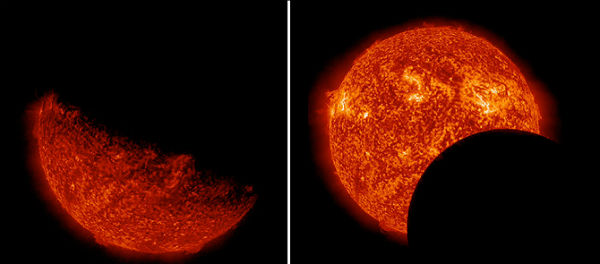SDO’s Earth eclipse and the lunar transit (March 11, 2013)

On March 2, 2013, NASA’s Solar Dynamics Observatory (SDO) entered its semiannual eclipse season, a period of three weeks when Earth blocks its view of the Sun for a period of time each day. On March 11, 2013 SDO experienced two different eclipses – The Earth and the Moon both traveled between SDO and the Sun.
The eclipse caused by the moon looks far different. Since the moon has no atmosphere, its curved shape can be seen clearly, and the line of its shadow is crisp and clean. Any spacecraft observing the Sun from an orbit around Earth has to contend with such eclipses, but SDO’s orbit is designed to minimize them as much as possible, with only two three-week eclipse seasons each year. The 2013 spring eclipse season continues until March 26. The fall season will begin on September 2.
 Left: The view of the sun is partially obscured by Earth (on the left) the moon crossing in front of the sun seen by NASA’s SDO spacecraft. (Credit: NASA/SDO)
Left: The view of the sun is partially obscured by Earth (on the left) the moon crossing in front of the sun seen by NASA’s SDO spacecraft. (Credit: NASA/SDO)
Credit: NASA SDO

Commenting rules and guidelines
We value the thoughts and opinions of our readers and welcome healthy discussions on our website. In order to maintain a respectful and positive community, we ask that all commenters follow these rules.